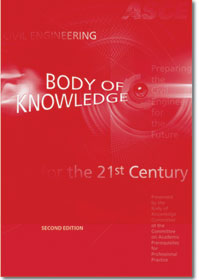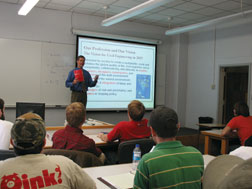Civil Engineers Unveil Updated Road Map For Profession’s Future Knowledge Journey
 |
But academics and practitioners who long have labored on the effort now believe the result is historic a new road map to successful civil engineering practice in a more complex world that expects faster and better results. While some worry about extra cost and time constraints of added education, proponents say the broadened outlook is injecting excitement into civil engineering study and practice, which will attract more students to the field.
After nearly a year in draft, the American Society of Civil Engineers released with fanfare on Feb. 19 the latest edition of the “BOK,” a 182-page reform and expansion of current educational requirements for civil engineers before they obtain licenses and practice professionally. The document packages the breadth of civil engineering knowledge and skill into 24 key areas, dubbed “outcomes” and makes clear that today’s four-year engineering degrees are not sufficient to create tomorrow’s professionals.
“It is entirely possible that the fourth-grade teacher who inspires a young student to become a civil engineer is required to have a higher level of education than the engineer will when he or she begins designing and building the roads, bridges and water systems that support our global society,” ASCE President David G. Mongan told an industry gathering in Washington, D.C. “I find that troubling. We must command our future, or others will do it for us.”

University of Alabama professor Fridley says new curriculum excites students.
|
Reform advocates, including Jeffrey Russell, head of the civil and environmental engineering department at the University of Wisconsin-Madison, say engineering is lagging other professional disciplines such as law, pharmacy, accounting and medicine in levels of education, esteem and compensation. “New complexities are driving a need for change, as well as global competition and customers with higher expectations,” he told meeting attendees.
The new BOK document advocates a restructured undergraduate engineering degree with 30 additional credits in the form of either a master’s degree or practical experience before civil engineers can obtain a professional license. That requirement was recently adopted by the U.S. engineer licensing body, the National Council for Examiners for Engineering and Surveying, to take effect by 2015 in individual states.
Earlier this year, Nebraska became the first state to introduce legislation to change engineer-licensing provisions. If enacted, the bill would apply BOK rules to engineers of all disciplines seeking licensure in the state by 2015.
| + click to enlarge |
 New skills and dimensions of civil engineering practice are built into ASCE-developed prelicensing requirements.
|
In addition, BOK developers have organized areas of “knowledge, skill and attitude” into 24 new groups that expand depth in math and science fundamentals and offer needed exposure to nontraditional areas such as communication, public policy, leadership, teamwork, business and ethics. On-the-job learning, often sponsored by employers, will be key to fulfilling many of the requirements.
BOK committee Vice Chairman Ken Fridley, who also chairs the civil engineering department at the University of Alabama, Tuscaloosa, says 11 U.S. universities are now testing BOK concepts in the classroom and are moving to develop new educational best practices.
Those schools include Bucknell University, Lewisburg, Pa.; North Carolina State University, Raleigh; University of Arkansas, Fayetteville; University of Alabama; Louisiana State University, Baton Rouge; University of Northern Arizona, Flagstaff; University of Southern California, Los Angeles; Montana State University, Bozeman; Iowa State University, Ames; Texas A&M University, College Station; and Rose Hulman Institute of Technology, Terre Haute, Ind.
|
“We must command our future, or others will do it for us.” — DAVID G. MONGAN, PRESIDENT, ASCE
|
Fridley says use of a body-of-knowledge-inspired curriculum over the last four years has had a major impact at his own university. “We stripped away our program, one of the oldest in the U.S., and completely reformulated it,” he says.
Fridley contends the results have been “positive and dramatic,” including a 130% increase in civil engineering enrollment. “That’s 300 undergraduates we didn’t have three years ago,” he notes. Fridley reports that the quality of entering students also is higher, noting a two-point rise in average ACT test scores. “We’re getting more and better into our program and into the profession,” he points out. “Students want to be part of the vision.”
 Engineers must ‘raise the bar.’
|
Some say other engineering disciplines have been slow to adopt similar prelicensing educational changes. That may be changing, claims ASCE Executive Director Patrick J. Natale. He told attendees the American Institute of Chemical Engineers “has flipped 180 degrees” on the issue and last year began to develop a BOK-type document.
Other groups representing environmental and mechanical engineers are doing likewise. The National Science Foundation sponsored the “5XME” workshop last May in Arlington, Va., for mechanical engineers. It was aimed at figuring out how to transform education for current and future U.S. practitioners to give them “five times the value added when compared to the global competition,” says NSF. “We have to get all the U.S. engineering societies together on this,” said Christopher Reseigh, senior vice president at Parsons Brinckerhoff. “We can’t afford duplication.”
While one BOK conference attendee commented that the changes could make a civil engineering license “unattainable,” advocates are adamant that reform is crucial. “There will be cost associated with this, but we’re looking toward the future,” says Richard Anderson, BOK committee chairman.



